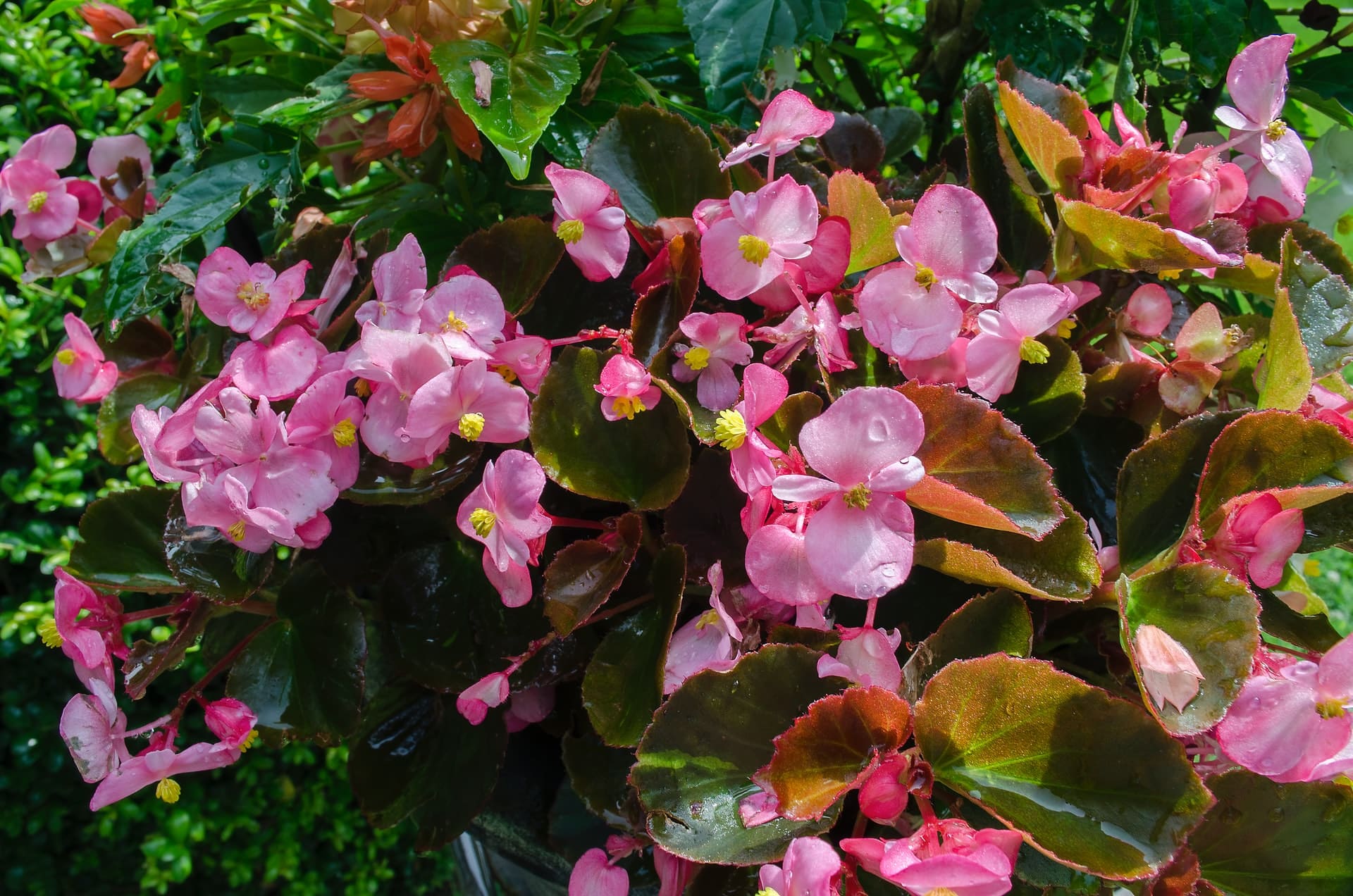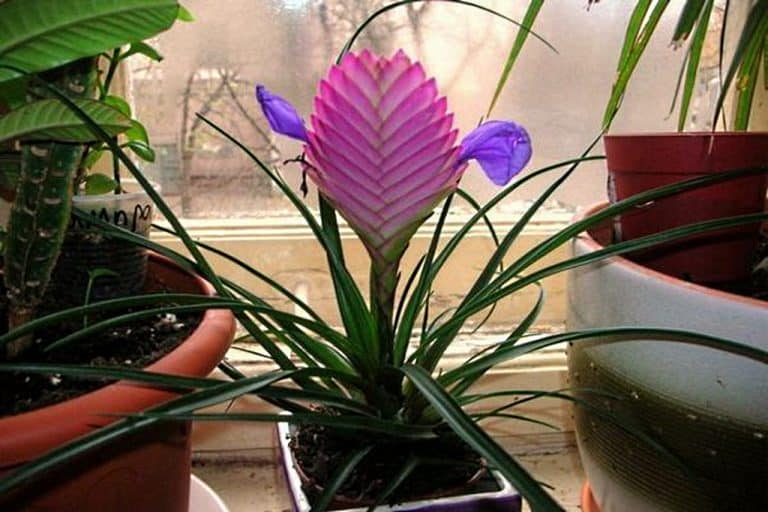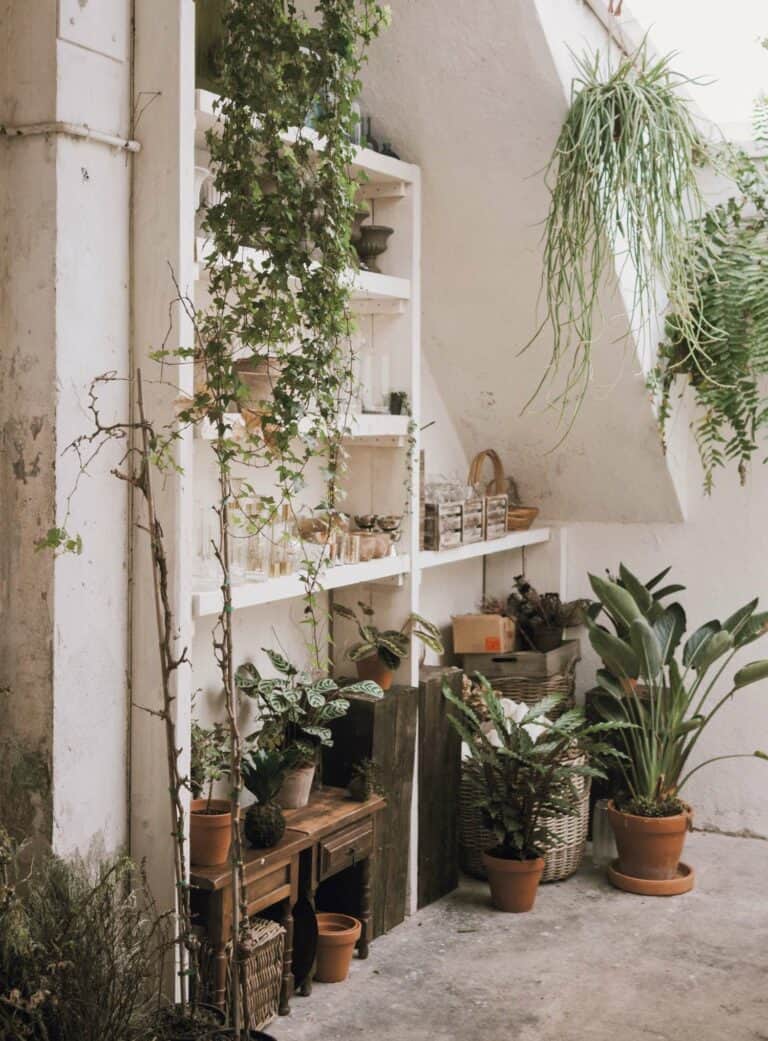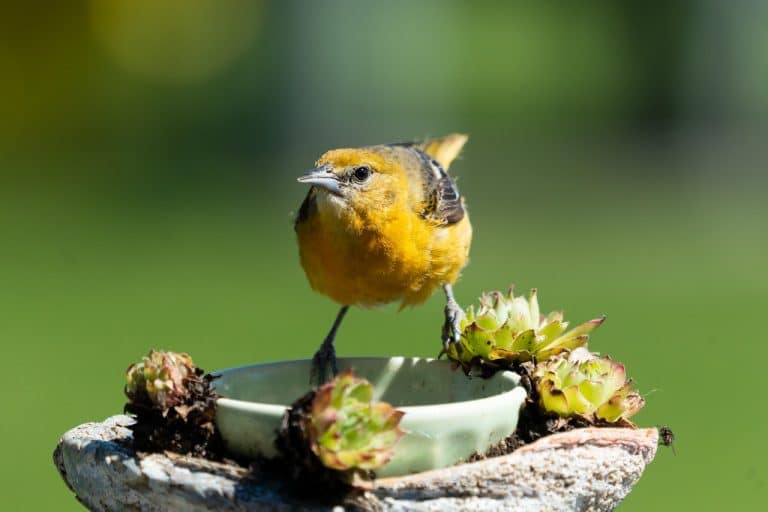Getting to Know Begonias
In addition to the three types of begonias described below, there are many more available from specialty greenhouses and collectors.


Begonias
FAMILY: BEGONIACEAE ORIGIN: SOUTH AMERICA
Begonia × corallina, other species and hybrids be-GO-nee-uh ko-ra-LEE-nuh
ANGEL-WING BEGONIA, CANE BEGONIA
WITH MARVELOUSLY MARKED LEAVES and elegant pendant flower clusters, angel-wing begonias are the best types to grow as house-plants.
There are dozens of species and named hybrids, which vary in size, leaf variegation, and flower color.
Dwarf selections grow to only 12 in/30 cm and can be kept as table plants, while large ones become nearly shrublike within a few years’ time, often growing more than 36 in/90 cm tall and wide.
Bloom time varies with cultivar, but most angel-wings bloom best in late winter and spring. The varieties named below are among the strongest rebloomers, often producing several flushes of flowers at different times of year.

SPECIFICATIONS
Light: In spring and summer, bright filtered light with no direct sun. In fall and winter, bright light, including up to 4 hours of direct sun.
Temperature: Average room temperatures (65–75°F/18–24°C) year-round.
Fertilizer: Feed every 2 weeks with a high-phosphorous plant food mixed at half the normal strength.
Water: Allow soil to become dry to within 1 in/2.5 cm of the surface between thorough watering.
Soil: A light, peaty soilless mix such as African violet potting soil.
Repotting: Repot annually in spring, shifting plant to a slightly larger container. Add pebbles or broken crockery to the bottom of the pot to increase weight and improve drainage. Very large specimens may need staking.
Longevity: 4 to 5 years, or indefinitely when propagated from stem tip cuttings.
Propagation: In spring or summer, root nonflowering stem tip cuttings in perlite, seed-starting mix, or a half-and-half mixture of peat moss and sand.
Selections: ‘Bubbles’ is naturally dwarf, and produces orange-red flowers almost continuously. Pink-flowered ‘Looking Glass’ grows 12–36 in/30–90 cm tall, and features metallic silver leaves with olive green veins and red undersides.
The dark reddish leaves of ‘Cracklin Rosie’ are speckled with pink, while long-limbed ‘Sophie Cecile’ has green leaves speckled with white.
For hanging baskets, white-flowered ‘Orococo’ is a real beauty, with ivy-shaped, green-gold leaves edged with dark red.
Display tips: Angel-wing begonias are beautiful year-round, and deserve a prominent position where they can be admired constantly.
FAMILY: BEGONIACEAE ORIGIN: INDIA AND SOUTHEAST ASIA
Begonia rex, B. masoniana, other species and hybrids bee-GO-nee-uh REKS, b. may-so-nee-AN-uh
FANCY-LEAFED BEGONIA, PAINTED-LEAF BEGONIA, REX BEGONIA, IRON CROSS
BREATHTAKING TO BEHOLD, fancy-leafed begonias produce large leaves, to 6 in/15 cm long, dramatically marked with silver, green, pink, and burgundy.
They need slightly less light than blooming begonias, and do well when grown under fluorescent lights. Pinching off buds and blossoms helps to maintain large, healthy leaves.
To provide the high humidity these begonias crave, cover plants with a plastic tent at night, which works like a humidity chamber.
Fancy-leafed begonias sometimes shed their leaves and become dormant in winter. When this happens, clip off the withered leaves, allow the soil to become almost dry, and enclose the pot in a plastic bag.
Keep it at 60°F/16°C until new growth appears, 6 to 10 weeks later.

SPECIFICATIONS
Light: Bright indirect light or fluorescent light year-round.
Temperature: Average room temperatures (65–75°F/18–24 cm) year-round.
Fertilizer: From spring through fall, feed every 2 weeks with a balanced houseplant fertilizer. In winter, feed plants monthly unless they are dormant.
Water: Water lightly yet frequently to keep soil constantly moist, but avoid overwatering. Plants need moderate to high humidity, but heavy misting can cause spots to form on leaves. Use trays filled with moist pebbles, a humidifier, or a plastic tent instead.
Soil: Use a light-textured, fast-draining medium such as African violet mix.
Repotting: Using shallow pots, repot plants in early spring so the rhizome is barely visible at the soil’s surface. Repot dormant plants as soon as new growth appears.
Longevity: Individual plants grow for 2 to 3 years, but can be kept indefinitely when propagated from stem or leaf cuttings.
Propagation: You can divide rhizomes when repotting, but it’s safest to root medium-sized leaves in early summer; handle these like petiole leaf cuttings.
Selections: ‘Iron Cross’ begonia (B. masoniana) features apple green leaves marked with dark brown crosses; leaves have a distinctively puckered texture.
Leaves of various B. rex and B. boweri hybrids may be spotted, as in varieties with ‘Tiger’ in their name. Other hybrids show flaming variegation patterns in pink, silver, and various shades of green.
Display tips: Young plants are ideal for tank-sized terrariums. Larger plants demand exacting care and high humidity.
FAMILY: BEGONIACEAE ORIGIN: HYBRID OF TUBEROUS AND WAX BEGONIA SPECIES
Begonia × hiemalis bee-GO-nee-uh hy-MA-lis
WINTER-BLOOMING BEGONIA, REIGER HYBRID BEGONIA
CREATED IN 1955, WINTER-BLOOMING BEGONIAS are usually called Reiger hybrids. Ongoing breeding work continues to improve these plants, which are increasingly available on the brink of bloom in early winter.
Mature plants in full flower stand 12–18 in/30–45 cm tall. They feature numerous camellia-like blossoms, to 2 in/5 cm wide, that may be red, pink, salmon, orange, or yellow. To prolong flowering time, gingerly pinch off individual flowers as they fade.
These plants are bred for a single season of enjoyment, but it is possible to keep them from year to year. When flowering subsides, taper off water and allow plants to become nearly dry.
Cut foliage back to 3 in/7.5 cm, allow plants to rest for 6 weeks, then commence watering. When new stems are 3 in/7.5 cm long, cut them off and root them; discard the parent plant.
In the fall, keep plants in natural light, since short days (less than 12 hours long) and cool nights trigger the formation of buds.

SPECIFICATIONS
Light: Near a cool, bright window.
Temperature: At night, 60°F/16°C. During the day, 70–75°F/21–24°C year-round.
Fertilizer: Feed every 3 weeks with a high-phosphorous fertilizer mixed at half the normal strength.
Water: Allow soil to dry to 1 in/2.5 cm below surface between thorough soakings. Keep plants on trays filled with damp pebbles to increase humidity.
Soil: Fast-draining mix that includes peat and perlite, such as African violet potting soil.
Repotting: Should plants become rootbound, shift them to slightly larger pots.
Longevity: 6 months, or indefinitely when propagated from stem tip cuttings.
Propagation: After plants have been cut back, rested, and begin to regrow, take 3 in/7.5 cm–long stem cuttings and root them in damp perlite, seed-starting mix, or a half-and-half mixture of peat moss and sand, as described on page 300.
Selections: Labeled as ‘Eliator’ or ‘Reiger’ hybrids, it is best to buy plants that show good bud color but have not yet begun to bloom.
Display tips: These are ideal plants for a sunny winter windowsill, where they can be teamed with amaryllis, cyclamen, and other winter-blooming plants.
Bromeliads
COMMONLY KNOWN AS THE PINEAPPLE FAMILY, bromeliads
They grow wild in the rain forests of South America. The first bromeliad brought to Europe was indeed the pineapple, which Columbus found growing in the West Indies in 1493.
After that, nearly 300 years passed before other bromeliads were introduced to the civilized world. These plants were grown in the conservatories of wealthy Europeans, and only gradually made their way into the houseplant world.
Compared to other houseplants, bromeliads are definitely newcomers.

All bromeliads are members of the Bromeliaceae family, which includes many plants that grow in the crotches of tree limbs, others that anchor themselves to rocks, and some that sink their roots into the forest floor.
Bromeliads are unique in their ability to absorb moisture and nutrients from the air through tiny leaf scales, called trichomes. In addition, many species form rosettes of stiff leaves that overlap at the base to form a reservoir that holds water.
Often called a cup or tank, this reservoir provides the plant with water and nutrients, which are released as insects and forest debris caught in the cup slowly decay.
In homes and offices, most bromeliads need a moderately moist environment where they can receive direct light for half the day.
Some species tolerate dry air better than others, but all bromeliads grow best when humidity levels hover around 50 percent. They are therefore good plants to partner with ferns and other plants that need moist air.
Bromeliad roots are quite skimpy, so they can be kept in smallish pots. For a dramatic display, you can grow young plants tethered to pieces of wood or large stones, with their roots wrapped in sphagnum moss.

All bromeliads bloom, usually when the plants are 3 to 5 years old. The blooms are actually clusters of colorful bracts, from which small, often vividly colored flowers emerge. T
he bracts persist for several weeks. After a bromeliad blooms, it slowly dies. But before it expires, the parent plant produces several offsets, or pups, which grow from the leaf crevices of the outermost leaves.
When the pups are a third the size of the failing parent plant, they can be cut away, repotted, and grown into the next generation.
Caring for Bromeliads
Read below about the best potting soil and watering and fertilization practices for bromeliads. Never use any type of oil to clean bromeliad leaves or control pests, since oil can interfere with the work of the leaf scales.
Also be careful where you place bromeliads, since the plants easily fall over when they become top-heavy, and some species have sharp spines along the edges of the leaves.
Light: Bromeliads vary in their preferences for light. Those with stiff leaves, such as urn plant and variegated pineapple, need more light than species that have more pliable foliage, such as queen’s tears.
The plant profiles that follow give specific light recommendations, but you also can memorize the phrase “soft leaf/soft light, hard leaf/hard light,” as a good rule of thumb.
In simple terms, bromeliads with soft leaves do well when grown near an east window, while those with hard leaves prefer the stronger light found by a west window.
Soft-leafed bromeliads are often kept indoors year-round, while those with stiff leaves enjoy spending part of the summer outdoors in a place that receives a few hours of morning or afternoon sun.
Temperature: Average room temperatures are fine for most bromeliads, which should never be chilled by temperatures below 60°F/16°C.
Some species, such as scarlet star (Guzmania) and flaming sword (Vriesea) resent temperatures above 80°F/27°C, so they are best kept indoors in climates with very warm summers.
Others, particularly air plant (Tillandsia) and variegated pineapple (Ananas), are much more likely to bloom if treated to a warm summer outdoors.
When moving plants outdoors in summer, gradually accustom them to increasing light levels, and never place them where they must endure intense midday sun. When shifted to bright light too quickly, bromeliad leaves can sunburn.
Fertilizer: Bromeliads are not heavy feeders, but they grow better when fed regularly in summer. Most grow best with an all-purpose liquid plant food diluted to half the normal strength.
With most bromeliads, it is best to spray the fertilizer solution on the leaves and into the tank, while also dribbling a small amount into the soil. See the plant profiles for specific feeding recommendations for each species.
As bromeliads reach maturity, which usually takes 3 years or more, you can encourage the formation of flowers by feeding them a small pinch of Epsom salts (magnesium sulfate).
Mix it into the water or fertilizer. The magnesium helps to initiate flowers. Another method for encouraging flower formation is to enclose a mature plant in a clear plastic bag along with a ripe apple or several apple cores for 1 to 2 weeks.
The ethylene gas given off by the apple helps initiate bud formation. To avoid overheating, be sure to keep the plant out of direct sun when it is enclosed in a plastic bag.
Water: Most bromeliads gather water in their tanks, or reservoirs, and only a little moisture from natural rainfall penetrates the leaves to reach the roots. Keep this in mind when watering bromeliads.
Many bromeliads are sensitive to minerals and chemicals in tap water, so they prefer rainwater or distilled water. Slow growth or browning of leaf tips can be due to hard water.
When watering bromeliads, spray a little water on the leaves, replenish the water in the reservoir, and dampen the soil only when it becomes very dry.
A few species need more moisture in their soil, but as with other houseplants, overwatering greatly increases the risk of root rot, especially in winter when temperatures may be cooler.
It is also good maintenance to dump out any water left in the reservoir after 10 days or so before refilling it with a fresh supply. If lifting the plant to empty the reservoir is too cumbersome, you can remove the old water with a bulb-type turkey baster.
Place slightly less water in the reservoir when the plants produce a flowering spike. Excessive water left sitting in the cup can cause the base of a flower spike to rot.
Soil: Most bromeliads take up nutrients and moisture through their leaves and cups, so they do not depend on their roots for sustenance the way most other plants do.
And, because many bromeliads are tree-dwellers, their roots are accustomed to sudden flushes of moisture followed by periods of dryness.
Fast drainage is therefore important, along with some air in the root zone. To meet these needs, use a special bromeliad mix comprised of 1 part peat moss, 1 part sand or perlite, and 1 part chopped, decomposed tree bark or pine needles.
This is an acidic mix, which is good. Never add lime to potting mixes used for bromeliads. If you prefer, potting soil developed for use with orchids is suitable for bromeliads.
Repotting: Bromeliads have scant root systems, and most grow best when kept in small pots. Restricted roots also control the plants’ size and may help them to flower, too.
Young plants that are actively growing usually benefit from yearly repotting, which is best done in spring. After 2 to 3 years, plants often can be held in a 5–6 in/12.5–15 cm pot until they bloom and produce offspring.
Whether you are repotting a large plant or small offsets, watch the planting depth and be careful not to set plants too deeply. Deep planting can cause a bromeliad to rot.
If the plant has such skimpy roots that it will not stay upright in its new container, surround it with a “fence” of wood skewers pushed into the soil. Remove them in a month or two, after the plant has established a sound anchor of new roots.

Propagating: Bromeliads are grown from offsets, often called pups. Some species develop offsets before they flower, but it is more typical to see pups emerging after the parent plant has bloomed and begun to decline.
If desired, you can trim back the failing leaves of the parent plant to give the pups more light, but do not remove it too soon. The offsets feed off of the deteriorating tissues of the parent plant.
Remove and repot the pups when they are one-third to one-half the size of the parent. It is usually best to do this by repotting the entire family. Use a sharp knife to separate the pups, and pot them in a lightly moist potting mix.
Planting the offsets in a very wet medium can cause them to rot. Offsets that grow quickly may need repotting in only six months, but most grow slowly, and can wait until spring to be moved into a slightly larger container.

Small details: Patience is important with bromeliads, which must be mature before they will bloom. Under ideal conditions, the bromeliad life cycle is completed in 3 years, but plants often need a year or two longer when grown indoors.
When buying plants, choose those that have not yet bloomed or have just begun to show a flower spike. Bromeliads in full bloom will expire within a few weeks, and you will have to wait years for another good show of flowers.

TROUBLESHOOTING
Tips of leaves turn brown
CAUSE: Conditions are too hot or too dry. In winter, increase humidity by placing plant near a humidifier or misting it every other day.
In summer, move plant to a shady place outdoors. Use a spray bottle to water the leaves, reservoir, and roots of the plant. Bromeliad pots should never be allowed to become completely dry.
Brown spots on leaves
CAUSE: Sunburn.
REMEDY: Expose plants to direct sun gradually, especially in summer when sunlight is very intense.
Plant rots at the base without blooming
CAUSE: Soil is too wet; insufficient air circulation.
REMEDY: Plants that develop root rot often cannot be saved.
Plant does not bloom
CAUSE: Immature; receives insufficient light.
REMEDY: Move to a slightly brighter location. Keeping plants in small containers helps encourage flower formation. Most bromeliads do not bloom until they are at least 3 years old.
Flower spike rots at the base
CAUSE: Too much water in reservoir.
REMEDY: Reduce the amount of water placed in the reservoir after the flower spike emerges. Instead, water plants by spraying the leaves until thoroughly wet, then dribbling water into the pots.
Offsets die without rooting
CAUSE: Offsets taken when too small; humidity too low.
REMEDY: Wait until the parent plant is nearly dead to remove pups. For the first 3 to 4 weeks after repotting offsets, enclose them in a plastic bag to maintain very humid conditions.
Brown disks on leaves
CAUSE: Scale insects.
REMEDY: These sucking insects occasionally infest bromeliads. Gently remove by hand by scraping them off with your fingernail. Repeat every few days, then spray plants with insecticidal soap after testing plant for tolerance.
White woolly patches on leaves, especially in crevices between leaves
CAUSE: Mealybugs.
REMEDY: Mealybugs are an occasional problem on bromeliads. Remove with a cotton swab dipped in alcohol; repeat every 3 days until the plants are clean.








